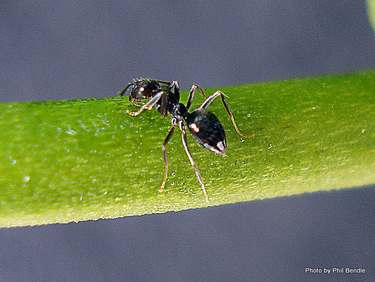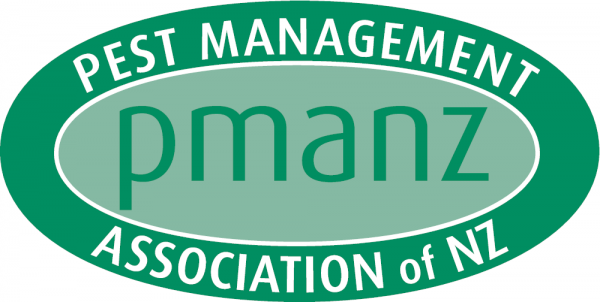Ants
(Information Courtesy of Landcare Research)
 INTRODUCTION
INTRODUCTION
Ants belong to order of insects known as Hymenoptera, which includes some of the most highly evolved insects. They have a caste system by which nest building, nursing of the young and foraging for food is undertaken by workers (sterile females), reproduction is performed by fertile females (queens) and males are responsible for the fertilization of the queens.
The nests of ants are usually located in shallow soil, hollow spaces in walls or cavity walls, under paving stones, concrete slabs and foundations of buildings.
New ant colonies are usually produced by a mating flight: males and females fly from the nest and mate in the air or on the ground. After mating females form a brood chamber and begin laying eggs. Workers of the first brood forage and feed the queen, expand the nest, and care for the next brood. The founding queen continues to lay eggs and remains in the nest.
When the colony reaches a certain size the queen lays eggs that develop into reproductive females and males.
There are about 10,000 different species of ants known in the world today. There are currently about 35 confirmed species from 23 genera in New Zealand. Of these, only 10 are native species, 9 of which are found only (endemic) in New Zealand. The endemic species are generally widespread geographically, mainly in forested habitats.
Recognition:
Three body regions (head, thorax, and abdomen) defined by distinct constrictions. Antennae elbowed (workers and queens; males sometimes straight) with last 1-4 segments usually enlarged, forming a club. Abdomen connected to thorax by 1 or 2 slender abdominal segments called nodes which form the pedicel (ant’s waist); enlarged rear portion of abdomen is the gaster.
Identification:
It is necessary to know which ant species you are encountering because ants vary widely in their food preferences and living habits.
The most common species we know in the urban environment as pests are:
- Argentine Ant (follow this link to video of behaviour and global spread)
- Big Headed Ant/Brown House Ant/Coastal Brown Ant
- Black House Ant
- Darwins Ant
- Pavement Ant
- Pharaohs Ant
- Southern Ant
- Tiny Brown Ant
- White Footed Ant
It must be pointed out that because of differing cultural and social sensitivities in some domestic homes, ants are usually only regarded as a nuisance, while others are deeply disturbed as there is a natural revulsion at finding insects in food.
Ants cause a problem in commerce and industries as they can contaminate foods, spread diseases, (e.g. Staphylococcus and Candida) and result in a loss of goodwill and prestige. Food containing ants has to be discarded to prevent contaminated food from being sold or served to the public.
Manufacturers, restaurants, bakeries, hotels, canteens and warehouses handle numerous foods and products that are highly attractive to ants. As contamination of foods or products can be particularly damaging to reputable companies, effective measures must be implemented to eradicate and control infestations located on the premises. Ants in products supplied to leading retailers may cause production to be stopped resulting in financial loss.
Ant nests are usually formed in the soil under stones, concrete paths, walls etc. In late summer and sometimes at other times of the year, swarms of winged male and female ants emerge to mate and disperse. Ants commonly feed on sweet sugary foods, but certain species will feed on fat and meat products.
Biology:
Ants have complete metamorphosis: egg, larva, pupa, and adult. They are social insects and the colonies contain 3 distinct castes: workers, queens, and males.
Workers are female, never with wings, and may live as long as 7 years. Although typically thought of as being sterile, workers of many species lay eggs that develop into males or are used by the colony as food (trophic eggs). Workers are either monomorphic, being of one form and size, or they are polymorphic, being of several forms which may vary greatly in size. Small workers are called minors, large ones majors or "soldiers", and those of in-between size are called intermediates or medias. Workers do all the work in the colony, which includes gathering food, caring for the young, and the enlargement of the nest.
Queens, which are typically the largest ants in a colony, function to establish new colonies and lay eggs. Once inseminated, they can lay fertile eggs for their lifetime which may be up to 15 years. For most species, a colony may contain many functional females or queens but only one founding queen. In the more common species, unmated females have wings and mated females chew theirs off. The male is usually between the worker and the queen in size and his only function is to inseminate the queen. Reproductives are usually produced only in very large or old colonies. Males die shortly after mating, usually within 2 weeks. For a particular species, if the females are winged, the males are also winged and retain their wings until death.
New colonies are founded at different times of the year, depending on the species. The swarmers (winged reproductives) usually come out of the nest, mate, and the inseminated queens chew off their wings and start a new colony in a suitable habitat. However, Argentine and Pharaoh ant swarmers produce no external swarm and mate in the nest, with new colonies being established by budding. All colonies of a particular species tend to swarm at the same time in a given area.
Adult ants, workers and reproductives, do not eat solid food. Instead, they eat only liquids which may be stored in their crop. Workers may regurgitate a tiny droplet of liquid to a fellow ant when solicitated by antennal palpations or stroking. Larvae are fed pre-digested or regurgitated food. Older larvae may process solid food into liquid form.
Control: ( Ant control is a 5-step process)
- Correct identification.
- Location of the nest(s).
- Baiting and/or insecticide application.
- Perimeter barrier treatment.
- Non-chemical control methods such as removing harborage or exclusion.
Related Content
- Code of Practice for the Food Industry
- Using Pesticides Around the Home
- Stay safe when using Poisons around the home
- Advice for Vets about rodenticide poisoning
- Ants
- Bed Bugs
- Bees
- Black Beetle
- Black Field Cricket
- Brown Marmorated Stink Bug
- Click Beetle
- Cluster Flies
- Cockroaches
- Flies
- Mice
- Mosquitoes
- Rats
- Spiders
- Tropical House Cricket
- Wasps
